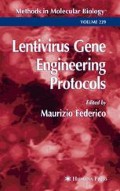Abstract
A mammalian cornea can be maintained in vitro for days (1,2), allowing ex vivo transduction of this tissue prior to transplantation (3,4). Ex vivo transduction of the cornea is useful for studying the efficacy of gene products on inhibition of corneal neovascularization (4), amelioration of corneal inflammatory disease, or promotion of corneal wound healing in animal models. Ex vivo transduction can also be used for transfer of genes into corneal epithelial stem cells (5), thereby allowing genetically modified stem cells to be reimplanted into the limbal area (6), providing a means for long-term gene-replacement (e.g., βig-h3 gene) therapy for various inherited corneal diseases (7).
Access this chapter
Tax calculation will be finalised at checkout
Purchases are for personal use only
References
Frueh, B. E. and Bohnke, M. (1995) Corneal grafting of donor tissue preserved for longer than 4 weeks in organ-culture medium. Cornea 14, 463–466.
Redbrake, C., Sallas S., and Frantz, A. (1998) Changes in human donor corneas preserved for longer than 4 weeks. Cornea 17, 62–65.
Larkin, D. F., Oral, H. B., Ring, C. J., Lemoine, N. R., and George, A. J. (1996) Adenovirus-mediated gene delivery to the corneal endothelium. Transplantation 61, 363–370.
Yoken, J., Chen, S. L., McFarland, T., et al. (2002) Production of a lentiviral vector containing an endostatin:kringle-5 fusion gene an inhibitor of post-penetrating keratoplasty neovascularization. IOVS Presentation S1868.
Bradshaw, J. J., Obritsch, W. F., Cho, B. J., Gregerson, D. S., and Holland, E. J. (1999) Ex vivo transduction of corneal epithelial progenitor cells using a retroviral vector. IOVS 40, 230–235.
Tsubota, K., Satake, Y., Kaido, M., et al. (1999) Treatment of severe ocular-surface disorders with corneal epithelial stem-cell transplantation. N. Eng. J. Med. 340, 1697–1703.
Munier, F. L., Korvatska, E., Djemai, A., et al. (1997) Kerato-epithelin mutations in four 5q31-linked corneal dystrophies. Nat. Gen. 15, 247–251.
Price, F. W., Whitson, W. E., Collins, K. S., and Marks R. G. (1993) Five-year corneal graft survival. Arch. Ophthalmol. 111, 799–805.
Vail, A., Gore, S. M., Bradley, B. A., Easty, D. L., and Rogers, C. A. (1993) Corneal transplantation in the United Kingdom and Republic of Ireland. Br. J. Ophthalmol. 77, 650–652.
Bourne W. M., Hodge D. O., and Nelson L. R. (1994) Corneal endothelium five years after transplantation. Am. J. Ophthalmol. 118, 185–196.
Oral, H. B., Larkin, D. F., Fehervari, Z., et al. (1997) Ex vivo adenovirus-mediated gene transfer and immunomodulatory protein production in human cornea. Gene Ther. 4, 639–647.
Fehervari, Z., Rayner, S. A., Oral, H. B., George, A. J., and Larkin, D. F. (1997) Gene transfer to ex vivo stored corneas. Cornea 16, 459–464.
Budenz, D. L., Bennett, J., Alonso, L., and Maguire, A. (1995) In vivo gene transfer into murine corneal endothelial and trabecular meshwork cells. IOVS 36, 2211–2215.
Tanelian, D. L., Barry, M. A., Johnston, S. A., Le, T., and Smith, G. (1997) Controlled gene gun delivery and expression of DNA within the cornea. Biotechniques 23, 484–488.
Oshima, Y., Sakamoto, T., Yamanaka, I., Nishi, T., Ishibashi, T., and Inomata, H. (1998) Targeted gene transfer to corneal endothelium in vivo by electric pulse. Gene Ther. 5, 1347–1354.
Wang, X., Appukuttan, B., Ott, S., et al. (2000) Efficient and sustained transgene expression in human corneal cells mediated by a lentiviral vector. Gene Ther. 7, 196–200.
Yang, X.-J. (2001) Preparation of recombinant retroviruses, in Vision Research Protocols (Rakoczy, P. E., ed.), Humana, Totowa, NJ, pp. 171–190.
Gorman, C. M., Howard, B. H., and Reeves, R. (1983) Expression of recombinant plasmids in mammalian cells is enhanced by sodium butyrate. Nucleic Acids Res. 11, 7631–7648.
Murthy, R. C., McFarland, T. J., Yoken, J., et al. (2003) Ex vivo transduction of corneas with a novel fusion gene inhibits angiogenesis and graft failure in a corneal transplantation model. Invest. Opthalmol. Vis. Sci., in press.
Author information
Authors and Affiliations
Editor information
Editors and Affiliations
Rights and permissions
Copyright information
© 2003 Humana Press Inc.
About this protocol
Cite this protocol
Appukuttan, B., McFarland, T., Stout, J.T. (2003). Corneal Cells. In: Federico, M. (eds) Lentivirus Gene Engineering Protocols. Methods in Molecular Biology™, vol 229. Humana Press. https://doi.org/10.1385/1-59259-393-3:197
Download citation
DOI: https://doi.org/10.1385/1-59259-393-3:197
Publisher Name: Humana Press
Print ISBN: 978-1-58829-091-5
Online ISBN: 978-1-59259-393-4
eBook Packages: Springer Protocols

